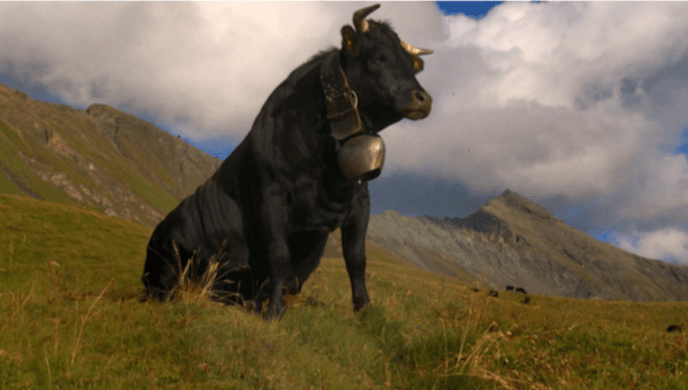Try To Find a Big Screen If You’re Seeing ‘Vedette’
While the concerns of an aging cow may not be blockbuster material, the picture’s setting — the Valais in Switzerland, an encompassing landscape that includes the Matterhorn — fits that bill.

Would that the Ziegfeld Theatre were still with us. While the building at 54th Street just west of Sixth Avenue has been rechristened the Ziegfeld Ballroom, a “premier special events venue,” gone are the days when you could sit in front of that big screen — I mean, really big screen — and get lost in the spectacle of cinema.
“Vedette,” the new offering from French documentarians Claudine Bories and Patrice Chagnard, is the type of film that leaves one dreaming of the old Ziegfeld. The concerns of an aging cow may not be blockbuster material, but the picture’s setting — the Valais in Switzerland, an encompassing landscape that includes the Matterhorn — deserves a venue larger than most theaters nowadays provide. The crispness of form, light, and color of “Vedette” was staggering even on a modest screen. Mr. Chagnard’s cinematography beggars the most extravagant of adjectives. So much splendor, so little time.
Movie-goers not conversant in French may initially think that “Vedette” takes place in Spain. What we see at the beginning of the picture is redolent of a bullfight: an arena full of cows, charging at each other, with a sizable audience in attendance. A panel of judges, a decidedly homespun bunch, oversees the competition. The announcer informs spectators that “a cow which abandons or refuses a fight is declared the loser.” The question remains: The loser of what?
Welcome to the world of Hérens cow fighting. Bred in the Val d’Hérens, a locale of uncanny purity, this species is renowned for its female members being peculiarly aggressive. Even though the cows are fairly pugnacious, their matches are bloodless affairs: The horns of each animal are sanded down. After a contestant has been defeated three times, it is put out to the proverbial pasture. The last cow standing is dubbed queen, bestowed with a floral tiara, and lavished with applause.
Earning the title is no small distinction for the owners of the animal. Pride figures into it, as does financial gain. Vedette, victor of the filmed fight and a longtime holder of the title, is worth a pretty penny, not least because her progeny may end up as queens themselves. When Ms. Bories asks Elise and Nicole, the farmers who fostered and care for Vedette, what the asking price for a queen might be, they demur. There are some matters too crass to be discussed in casual conversation.
What happens when the reigning champion loses her crown? That’s the crux of “Vedette.” About three-quarters of the way through the movie, we watch as Vedette, age having caught up with her, relinquishes her throne and Elise and Nicole decide that their queen needs to be separated from the herd. Isolation, they insist, is the best way to staunch Vedette’s feelings of humiliation. They gently strong-arm Ms. Bories, who has a house down the way, into adopting the cow; she agrees. At which point, the filmmaker loses any pretense to objectivity, and becomes a player in her own film.
Even the most stringent documentarian trades in a degree of self-acknowledgement, and there is notable precedent for doing so — “Grey Gardens,” say, or “My Kid Could Paint That.” Ms. Bories, aided by co-conspirator Mr. Chagnard, fares better when concentrating on the particularities of cattle farming than on her own attempts at relating with Vedette. While there is a certain brittle comedy to be had from reading Descartes to a cow, Ms. Bories’s decision to do so says more about her own affectations than with the complexities of the natural world.
Ms. Bories and Mr. Chagnard deserve commendation for down-playing their political inclinations. Indeed, the upshot of the film runs contrary to the stated goal of proving “there can be no human-centric planet.” There remains, in fact, ample opportunity to question just how much sentience can be attributed to even so regal an animal as our title heroine. Having said that, “Vedette” merits admiration for shining light on one of the more rarified corners of our human-centric planet.

